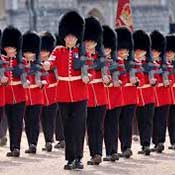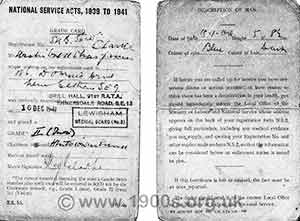
Experiences of post-war National Service in the Grenadier Guards
Personal recollections by Peter Johnson

The call-up
I was 18 years old in September 1952. This was the call-up for National Service. About a week later I received a brown card through the post telling me that I should attend a medical.
The medical
On the due date I had a chest X Ray at the Air Ministry in Gower Street, followed by a full medical at a military depot at Wanstead Flats. We recruits entered a large hall around which was a bench. In the centre of the hall was a long row of tables behind which were seated doctors in white coats. Having removed all our clothes, which we had to leave in a pile on one of the benches, we passed down the hall to be inspected by each doctor. There must have been at least fifty of us standing there naked - one of the worst moments of my life. Yet another brown card arrived stating that I was completely fit.
Medical grade card for my uncle who was called up to serve during wartime. The card may have been slightly different for post-war national service. Those in medical grades I, II and III would have been deemed fit for service, albeit in different capacities.
Caterham for basic training
A couple of weeks later I received yet another brown card instructing me to report to the Guards Depot at Caterham on the 6th November 1952, a date I will never forget. I was now a member of the Grenadier Guards. I was issued with all the army kit to start 12 weeks basic training.
The Grenadier Guards uniform
The whole of the British and Commonwealth armies wore the same battle dress, in action, on parade and for going on leave. National Service, Regulars and Territorials were all in the same army doing the same job. The only thing that differed was the headdress and the shoulder flashes, i.e. the name of regiment.
For 'fatigues', i.e. menial duties like spud bashing, we would not wear a tie or gaiters.
Bearskins
Foot Guards wore - and still wear - Bearskins which were designed to protect the head from cavalry sword slashes, as the fur is attached to a wicker basket. The face is protected from sword slashes by a Curb Chain which hangs between the lower lip and the chin. Busbies are different; they are worn by the Horse Artillery and are shorter in height with the strap worn under the chin.)
Foot drill
The foot drill was hell on earth, chased from dawn to dusk. Eat, sleep, drill and bull shit were now my life. Upon reaching the required Guards standard, there was our final inspection.
Weapons and battle training mainly at Pirbright and the Yorkshire Moors
My training for the work that I would eventually be doing consisted mainly of weapons training at Pirbright for 8 weeks, followed by 2 weeks on the Yorkshire Moors for battle training with live rounds. We spend months training to kill people, yes kill people in cold blood. What other occupation does this? During this period, I also took part in the 1953 Flood Disaster at Southend on Sea and Queen Mary's funeral. It was the first time I had worn a bearskin in public. Then there was the Coronation.
Active service overseas in Egypt
After my training and some leave, came what I might call my real job.
This was off to Egypt by boat for what was active service, with as much sunshine as anyone could have wanted. For nine months we lived in a tent, with two nights on duty and two nights off. This was one place I was glad to get away from.
Here I was at the age of 18, being shot at and going out on patrol wondering if the next step I took would be my last because somebody had planted a land mine. It concentrates the mind. I slept in bed in full uniform with a loaded weapon strapped to my wrist, ready at a moment's notice to defend myself. What civilian job compares with this?
The noise, the smell, the fear, this was now my way of life. Would it ever end! And when this hell on earth does come to an end we would return to family, house and job and be expected to carry on as though nothing has happened.
Public Service in the UK as a Guard
Then it was back on a boat for a two-week trip to the UK, and Chelsea, London for what were called public duties. We were after-all guardsmen which meant that the public expected to see us dressed up on formal guard duty.
My first guard duty was at the Tower of London, which was followed by the Bank of England, then St James's Palace and Buckingham Palace. By this time I had started to enjoy my time in the Guards. I was proud to walk down the street in my uniform, so much so that I am still a member of The Grenadier Guards Association. We meet once a month.
Demobilisation and the Territorial Army
After serving full-time for two years, that was not the end. I had to do three years in the Territorial Army in the Middlesex Regiment. All my kit and uniform were kept at home, and I had to report for training, one evening per week, with 4 weekend camps per year and 2 weeks training each summer. So there were no summer holidays for 3 years, all on only army pay.
This was camping under the stars, or under canvas, once in Essex, once in Thetford and once on Salisbury Plain, and it was in all weathers. The idea was to simulate an enemy invasion and how we would repulse it. The badge on our uniforms was the White Cliffs of Dover and in the event of the Russians rolling across Europe it would be our task to defend all the counties inland from Dover. I was part of some 90,000 men who would be recalled to defend this part of the southern counties. It was drummed into us that this was the last ditch defence. God help us if the Russians had got this far.
Once a Grenadier, always a Grenadier
"Once a Grenadier always a Grenadier". That is a regimental saying, meaning that, having served in the regiment you are a member to the day you pass on to glory.
The Brigade of Guards set the highest standards regarding good manners: always show respect, never be late, never make excuses and always be clean and tidy. All the male members of the Royal Family hold rank in the Brigade of Guards and set the standard to which we all aim for. It is not easy and sometimes not in fashion to maintain this way of life. It takes dedication and hard work.
Some definitions, etc
A BRIGADE is a battle formation consisting of three or more battalions joined together, under an officer who hold the rank of Brigadier,
A battalion consists of approximately: 800 soldiers, in wartime this would increase to 1,000 men.
The BRIGADE of Guards consists of 7 BATTALIONS, Grenadier, Coldstream, Scots, Irish, Welsh, Horse Guards and Blues and Royals. These seven regiments are called the HOUSEHOLD BRIGADE., and are responsible for the safety of the Royal Family.
The Queen and Prince Philip both hold ranks in the Grenadier Guards, as can be seen during Trooping the Colour. Other members of the Royal Family hold ranks in the other Guards Regiments.
During the late King's illness in 1948 Princess Elizabeth became Colonel in Chief of the Grenadier Guards and took charge of Trooping the Colour.
Page contributed by Peter Johnson
If you can add anything to this page or provide a photo, I would be pleased if you would contact me.
Text and images are copyright
sources: early 20th century material
sources: ww2 home front and other material
contact
the webmaster/author/researcher/editor
privacy policy

















